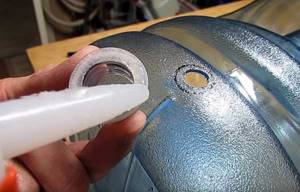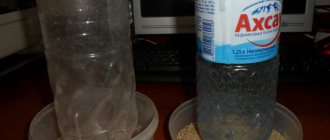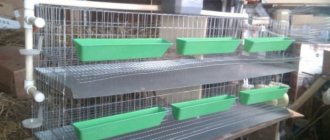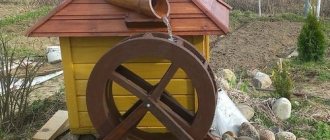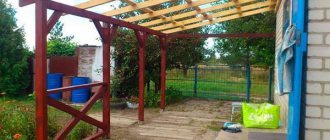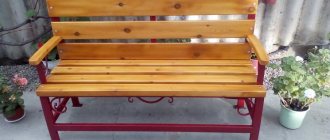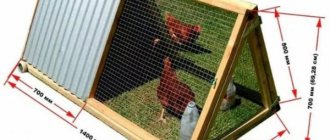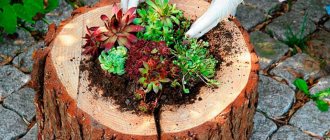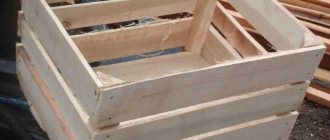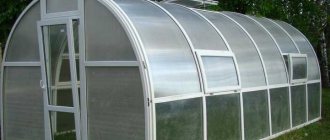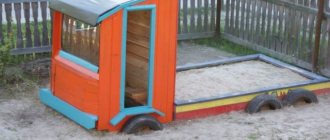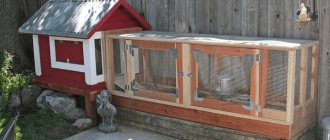Automatic feed mechanism
Farming can be very tedious, and chickens simply don't have the time to constantly keep an eye on their feeders. For a large farm, a do-it-yourself automatic broiler feeder is suitable, suitable for both adults and chickens. The food in such feeders lasts for a long time, and it is supplied as needed. To make a feeder and automatic drinking bowl for chickens you need:
- 2 pieces of plastic pipe;
- self-tapping screws;
- metal knife;
- two branches;
- plug and adapter.
Often, after repairing plumbing fixtures, pieces of plastic profiles remain in the household. If you don’t have them at home, they sell them in the store not so expensively. It is necessary to connect the pipes using an adapter, to which two half-bends must be connected. Having connected the two structures, attach them to the wall. If the number of chickens is large, it is not necessary to make several feeders. Longer pipes are connected to the tee and several holes are made to provide access to the feed.
Common mistakes
At the design stage, it is important not to make gross mistakes that will result in having to redo the entire structure of the building. This may include:
- Lack of protection against rodents. When drawing up a project, it is necessary that the cage is raised from the ground. Contact of insulation with the ground is unacceptable. This may lead to the threat of rats. They are able to chew through wood and penetrate into the structure. It is better to fill the lower zone between the heat insulator and the ground with broken glass.
- Use of unsuitable materials. Do not use isoboards, plasterboard, PVC plastic and chipboard for finishing. They accumulate moisture, as a result of which they collapse. In addition, toxic substances that are dangerous to chicks may be released. Due to increased humidity, mold forms, which leads to the development of various diseases in chickens.
It is quite possible to make a cage for hens or chicks with your own hands. To do this, you need to select the right materials, choose the type of structure and draw up its drawing. All the work is simple, so even a person who does not have the proper experience can cope with them.
Feeder construction technology
Now let's look at several manufacturing options: how to make such a structure with your own hands. You will also find photos and videos below.
Option 1
The simplest option would be to make an accessory with your own hands from a plastic bottle, which should have a handle.
In this case, it is important that the walls are quite strong and can hold their shape when exposed to influence. Measure about 6 cm from the bottom of the bottle and cut a hole through which the broiler will have access to food
Since the bottle is equipped with a handle, it can be easily hung on the mesh.
This accessory is considered a bunker accessory; it will help serve food to the bird as it is consumed. For example, instead of a bottle, you can use a small plastic bucket, but you will also need a saucer, similar to the one used for stands for flower pots. Also, holes are made at the bottom of the bucket through which the food will flow into the saucer; instead of the latter, it is quite possible to use the bottom of a large bucket.
A structure made in this way can stand on the ground or be used suspended. The main thing is that the plastic is more or less durable so that it can withstand the influx of a brood of chickens.
Option 2
An equally popular option is to use a structure made from PVC pipes. You will need pipes with a diameter of about 15 cm, as well as two plastic plugs and a pipe tee. The length of the tube is not important. From the total length you need to cut two pieces of 10 and 20 cm. After this, the 20-centimeter piece, as well as the remaining long piece, are connected using a tee, the remaining 10-centimeter piece is connected to the branch. In principle, this completes the procedure for creating the structure; plugs can be used to block access to food at night.
If you have a large brood, you can install several of these accessories. Or, as you can see in the photo, you can make holes in the pipe with your own hands, through which the chickens will consume food, and fasten the pieces of pipe together. As you can see, there is nothing complicated about this.
Option 3
How to make a wooden structure with your own hands, the drawing can be anything, consider an example with such a feeder as in the photo:
- So, decide on the dimensions and draw out all the elements of the future container on a piece of plywood.
- Using a wood saw or jigsaw, cut out all the necessary parts, and using a drill and drill bits, make holes for the screws.
- Then all rough places and surfaces need to be treated with sandpaper with a small diameter, this is done so that your birds do not get hurt.
- Using self-tapping screws and self-tapping screws, you need to fasten the side parts of the structure together, as well as the front wall and bottom. Having done this, you need to cut out an angle of 15 degrees at the top and bottom on the back and front walls. All elements must be installed flush with the top mark and attached to the side walls, using screws for this.
- After this, you need to make a part from the square beam with an inclination angle of 30 degrees, using self-tapping screws it needs to be secured to the structure. The last step is to install the cover to the side walls. To ensure that the structure lasts a long time, it can be opened with an antiseptic. To protect food from spoilage, the feeder should be placed outside the walking area.
Loading …
DIY chicken drinker
Water containers for the chicken coop can be purchased at the store (original drinkers) or made independently. Making a waterer for chickens with your own hands is quite simple. First you need to decide on the type. There are several of them - nipple, vacuum, cup, siphon, drip. They can be created from plastic bottles or PVC pipes. There are actually more ideas; many craftsmen make other types of drinking bowls for broilers with their own hands.
Nipple drinker
It is considered the most progressive way of watering animals. To do this, you will need a hole at the bottom of the bucket or in the cap of any plastic bottle. Then a nipple is screwed into the hole, the structure is installed in the desired location and filled with water.
Also, such a device can be made from PVC pipes. To do this you will need plastic pipes, pipe plugs, a clamp (polypropylene), nipples, a drill, waterproofing tape and a drill. You need to make marks on the surface of the plastic pipe and drill holes every 30 cm. Screw nipples into them, which must be wrapped with waterproofing tape. Then one end of the pipe is connected to the water supply, and a plug is inserted into the second and tightened with ties. Experts recommend installing trays or bowls under each nipple. This will avoid unnecessary spillage of water. In addition, the bird will have additional drinking containers.
Drinker for chickens from a plastic bottle
This simple container is well suited for those who have a very small number of chickens. Its main advantage is its efficiency, and its disadvantage is the lack of automatic water supply. A five-liter or 25-liter bottle (plastic) is suitable for its manufacture. Several holes are made in the container (holes are 3-4 cm long, 1.5 cm wide). The homemade structure is placed in another container - a cup or basin filled with water. As a result, when the liquid is drunk, the required amount of water will flow from the bottle through the holes into the container. In this case, the bottle cap must be tightly closed.
Important! It is advisable that the drinking bowl should be 20 cm above the floor level. This measure will save water from pollution.
Vacuum drinker
It looks like an inverted container of water, which is lowered into a special drinking vessel. As a result, water is kept in the container due to pressure and gradually flows into the bowl, replenishing it from time to time. To make it you will need a regular plastic bottle, the volume of which can be 5 or 10 liters.
Note! The plastic bottle should have a narrow neck.
Also, to make a manual vacuum drinker, you will need a water bowl or basin. The height of such a vessel should be no more than 10 cm for adult chickens and no more than 3 cm for young chickens. In addition, you will need a screwdriver, fasteners, and screws. You can use any plastic bottle directly as the tank itself. However, it is important to note that the diameter of the neck of such a container should be less than the diameter of the bowl. Using self-tapping screws, fasteners for the tank are screwed to the wall of the chicken coop, clean water is poured into the tank, and a bowl is placed at the opening of the tank.
DIY wooden feeder
The feeder made of wood looks original. In this case, you can use absolutely any drawing. The work will come down to just a few simple steps:
- First of all, you need to decide on the size and shape, and then draw out all the structural elements on the wooden surface.
- All parts must be cut exactly according to the markings using a jigsaw or wood saw, and then holes for the screws must be made with a drill.
- Sand all uneven and rough areas using sandpaper. This process must be completed without fail. This will protect the birds from harm.
- Use screws and self-tapping screws to fasten the side elements, bottom and front of the walls.
- After this, an angle should be cut out on the front and back walls in the lower and upper parts, which should be equal to fifteen degrees.
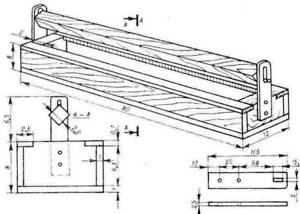
- Install the structural elements flush with the top mark and attach them to the side parts using ordinary screws.
- Now make a part, the angle of inclination of which should be thirty degrees. Attach this element to the main structure.
DIY chicken drinker
Many owners of private houses and private farms keep poultry: chickens, ducks, geese, turkeys. This is a profitable business; poultry farmers not only provide their families with organic meat and eggs, but also sell the surplus, thereby increasing their income. At the same time, some owners forget an important rule - in order for chickens to produce as many eggs as possible, it is extremely necessary to provide them with comfortable conditions. Otherwise, it will be difficult to get a good return from the bird, and even in poor conditions the living creatures risk dying. First of all, laying hens need clean water. Each hen usually requires half a liter per day.
Basic requirements for feeders
Feeders must comply with the following rules:
- A rational approach to feeding - feed dispensers must have a device that prevents birds from entering them (turntables, dividing sides). Only the bird's head can easily enter the feeder. If the device is more open and birds can climb inside, then the food will be raked with their paws and clogged with bird droppings.
- Simplicity and accessibility in operation and maintenance - the feed dispenser is used daily, it should be convenient for adding feed, cleaning and periodic washing. Moreover, both the convenience of the design of the feeder and the quality of the materials from which it is made are welcomed. The optimal feeder weighs little, is easy to move from place to place, can be easily washed with water, and does not change its physical and chemical properties after using disinfectants.
- Suitable size - both the size and capacity of the feeder are selected so that the feed inside is enough for the entire flock of birds for a full daylight hours. For adult broilers, 100-150 mm of feeder length per bird is needed; for chickens, 50-70 mm per chicken is enough. If the feed dispenser is disc-shaped, then 25 mm is enough to feed each adult chicken (so that only the beak penetrates). With the correct calculation of the number and length of feeders, all birds (strong or weak) will be able to be fed at the same time.
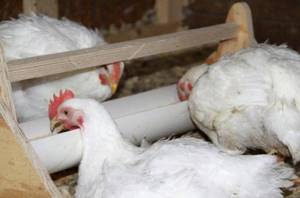
- A wooden feed dispenser is useful for feeding a chicken flock with dry feed (compound feed and grain) and feeding with mineral additives (chalk, shell rock, small pebbles).
- It is more convenient to place mixtures of succulent feed in plastic or metal feeders, since such feed dispensers require daily washing.
- Finely chopped green feed is fed to chickens from feeders with a lattice lid; the lattice may have a safety lid made of metal mesh or welded from thin steel wire.
We recommend reading about how to make an automatic chicken feeder.
Types of feeders:
- A tray is a shallow container with raised shallow sides into which food is poured. Feed trays are used for young birds.
- Trough feed dispenser - can be divided into sectors, each of which contains its own type of feed.
The upper part of such feeders is often covered with a thick metal grid to protect the contents from being raked by chicken paws. Typically, trough feeders are installed outside the broiler cages, but so that the birds can easily peck the feed.
- Hopper feed dispenser - used for portioned dispensing of dry food. This device allows the farmer to be away from the poultry farm for one to three days. The required amount of feed (grain or mixed feed) is poured into the central part of the bunker feed dispenser. Through a pipe connecting the hopper and the feeding tray, dry food flows into the lower part of the feeder. As the birds eat the food in the lower tray, new food comes out of the hopper in small batches. The device allows you to keep food dry and clean.
Did you know? You can put someone else's egg in the nest of a brood hen, which the mother will accept and hatch without objection. And the hatched duckling or gosling will be led along with its chickens, without distinguishing it from the brood in any way.
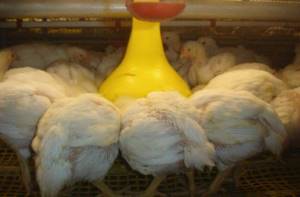
Requirements for drinking bowls for chickens
The main thing that is required from a chicken waterer in the first place is its availability for birds at any time, since they drink not according to a schedule, but according to the degree of their thirst.
In addition, drinking bowls for chickens should be:
- convenient for both birds and their owners when servicing devices;
- durable and resistant to influence from chickens;
- safe for birds in the sense that there are no sharp edges or corners that could injure them, and in terms of the non-toxicity of the materials from which the drinkers are made;
- closed to prevent litter and excrement from getting into them;
- heated in the cold season in an uninsulated chicken coop.
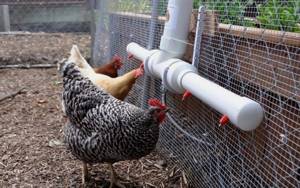
What are the requirements?
If you make a drinking bowl for chickens with your own hands, you will be able to save money, and you will also be able to adapt the item for specific birds. It is worth pointing out that experts have established certain requirements regarding drinking bowls
You need to pay special attention to them
They indicate that no matter what the design of the item in question is, as well as how it is made, a number of requirements must be observed.
These include:
- so that it is convenient for birds to use;
- establishing protection regarding pollution and spillage of water by chickens.
In a situation where a decision is made to use open-type drinkers, they need to be positioned at approximately the level of the bird’s back. This is done so that the drinking process is quite convenient and comfortable, in addition, it prevents the chickens from starting to bathe in such water. It is also worth pointing out that the structure should not have sharp edges or protruding nails, since a bird can easily get hurt on them.
It is worth pointing out that the item in question must be made from light and durable materials, and also firmly fixed in a place where the chicken cannot reach and overturn the drinker
In addition, pay attention to the fact that these structures do not need to be made of glass, since it has a large mass and there is a possibility that it will break and injure the chickens
It is also worth considering the question of what types of drinkers are available. There are several reasons why the division of these elements occurs, in particular, it may be a mechanism that is used to supply water to the bird. Based on this basis, one can distinguish such varieties as vacuum, cup, siphon, and nipple.
The main advantage of the latter variety is that the water is completely protected from debris getting into it and chickens cannot spill it. Birds will drink through the use of special valves. They grab it with their beak and suck out the water.
A variety of such drinkers includes the drip type. A drip tray is attached to it. They have some negative features, in particular, the fact that it is necessary to carry out the process of installing nipple valves to a significant extent in order to be able to avoid the formation of a queue for birds to drink.
Cup types of drinkers are more difficult to make independently. However, it is worth noting that this variety is more reliable in use, for this reason it is suitable for a large number of chickens. Regarding siphon drinkers, it can be noted that they function as communicating vessels. They allow you to fill it with water without going inside the chicken coop.
The only downside is that it requires periodic cleaning of accumulated debris. It should also be noted that there is such a basis for distinguishing varieties as the type of water supply to the device. In this situation, specialists distinguish such varieties as manual feed and automatic.
The latter type will be used in a situation where it is necessary to regularly change the water in the tank. This ensures that the bowl is automatically filled at the desired level, which occurs through the use of inherent design features. These types include cup and vacuum drinkers.
Sippy cup with spout made from fitting
This version of the drinking bowl is very easy to make. To make such a sippy cup, you only need a few pipes, which every owner may have lying around. The main thing is to decide where it will be installed so that the chickens can calmly come up and drink the water. It’s also worth thinking about the water supply in advance, but more on that a little later.
Tools and equipment
For this design you need to prepare:
- Medium-diameter sewer pipe 1 m long;
- L-shaped corner fitting (elbow) – 2 pcs.;
- Clamps 2-3 pcs.;
- Drill and screwdriver;
- Self-tapping screws up to 10 pcs.

Design for water
Step-by-step instruction
- Attach the corner fittings one after the other to the main pipe, you should get something like a spout from which the chickens can drink water.
- It is necessary to make marks in the wall where our plastic part will be attached, and use a drill to make holes.
- Place clamps on the structure and screw everything to the wall. The spout should be level with the bird's back.
- Carefully pour water on top until it appears in the spout. As you drink the liquid, the water will drop, and then you just need to top it up.
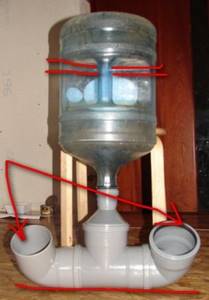
Convenient bird drinker
To make your life easier, you can run a hose to the chicken drinking bowl, which will be connected to the tap and, if necessary, simply turn on the water. There is another option. For it you just need to replace one of the fittings with a small piece of pipe of the same diameter. Only the free end must be closed with a plug and several holes with a diameter of 20 cm must be made at a distance of 15 cm from each other.
When water is supplied from above, it will remain at the level of the holes, and the chickens can easily come up to drink water. Moreover, not just one or two, but up to 5-6 chickens at once will be able to quench their thirst. This structure must also be mounted on the wall, at a short distance from the ground, so the water will always be clean. Sometimes it will be possible to remove the homemade sippy cup and rinse it under high pressure to remove the deposits there.
How to do it yourself?
It’s not difficult to make a chicken feeder from scrap materials; the main thing is to pick up everything you need and start creating a new product. The most popular and simplest option is to construct a container for feeding chickens from a 5-liter plastic bottle. The advantage of this container is its lightness, ease of work with it and the expected result
In order for the homemade design to work correctly, it is important to choose a container that will be slightly larger than the size of the bottle so that the food that the birds will consume is poured into it
The principle of creating such a feeder is very simple - round holes the size of a coin are cut in the base of the bottle, through which the food is poured. The plastic container is placed in a larger container, after which food is poured through the neck. As soon as the food from the tray is eaten, its supply will automatically be replenished with what is in the bottle. The number of such products is regulated by the number of poultry. There can be several such feeders to provide food for all the birds for the whole day.
A more complex design option involves the use of wood. To make the feeder convenient and neat, you must first create drawings and only then start working. The dimensions of the future product will depend on the design features and the number of birds. The wooden feeder is designed only for dry food, so it can be made in several versions.
A simple design involves creating a small trough into which the feed will be poured. This option is most often used in villages and dachas due to the ease of creating the product, but it has significant disadvantages: birds can scatter food, so much more of it will be needed, it becomes more polluted and the bird may receive poor-quality food, which will harm its health. The most correct option would be to create a wooden bunker feeder. The algorithm for its construction is as follows:
- you need to prepare all the necessary available tools and materials: saw, hammer, nails or screwdriver with self-tapping screws, boards or fiberboard/chipboard/plywood;
- create a drawing of the future structure;
- make markings on the material from which the feeder will be created;
- cut out the parts and connect them together.
The front part should have dimensions of 40 by 50 cm, the back part - 40 by 40 cm. The sides will have a cone shape and connect both parts of the structure. The lid must exceed the top of the product by at least 5 cm, and preferably 10, in order to protect the contents from foreign matter that negatively affects the quality of the feed. There is a small gap at the bottom of the feeder. Through it, food will spill into a special tray under the structure, which will allow the chickens to eat comfortably in the chicken coop.
A fairly new and original material option for creating a feeder is plastic pipes. A suitable diameter for this purpose will be at least 15 cm, and the length is selected taking into account the characteristics of the chicken coop and the number of birds. In addition to simple pipes, you also need to purchase a tee and plugs. There may be several design options.
A horizontally located pipe on which holes are cut, through which chickens can absorb food. Elbows pointing upward are placed on the sides of this pipe. A plug is put on one of them, the second is a working one, food is poured into it, after which the plug is also put on.
In the spring and summer, you can also build feeders for greenery, which are best made from metal mesh. It is rolled into a circle and filled with green food. If the feeder is created for chickens, then it is best to use a bunker version using a plastic bottle with a capacity of 1 to 2 liters, no more. The principle of creating such a product is the same and consists of making holes at the base and pouring food into the main part of the bottle.
DIY making
Creating drinking bowls for broilers with your own hands will not pose any particular problems, due to the very simple mechanism of action and the availability of construction materials. In fact, some types can be collected even from improvised means that every person probably has in their home. Whether it's a bucket, a hose or a regular plastic bottle, it can serve as an excellent reservoir for easily replenished water supplies.
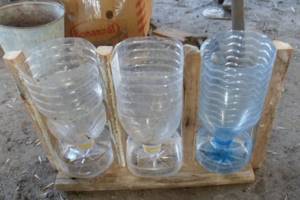
To create such a simple device, you only need the ability to work accurately and concentratedly, and also enough patience in case of failures. But before proceeding to a direct description of the process of manufacturing lightweight structures for watering, you should talk about their varieties, giving a person the opportunity to independently choose which version of the product he prefers for his yard.
Types of drinking bowls
There are several main types of designs, which will be discussed below to make the choice easier for future owners. Basically, they differ in the principle of operation and ease of creation.
Vacuum
They are the simplest to manufacture, very easy to operate and change the water inside. Outwardly they look like upside-down bottles in a small bowl. The principle of operation is extremely simple - the pressure in the plastic bottle does not release too much liquid, so the container fills slowly as it empties.

Its disadvantage is its low stability; an adult bird can easily overturn the structure. Because of this, it is better to install vacuum ones for small chickens who cannot press hard on objects. It’s very easy to make; a small canister or even a lemonade bottle will serve as a tank.
Nipple
Nipple drinkers for broilers are more complex to create, but are very effective due to improved internal operating mechanisms. All liquid is kept in a tightly locked container, eliminating the possibility of contamination due to environmental influences. It leaks only if there is sufficient pressure on the installed valves. It looks like this: the bird presses with its beak, the locking system is loosened and the nipple releases water in sufficient volumes for drinking.
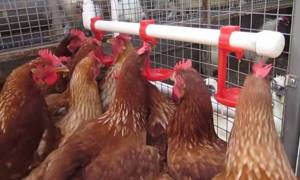
As a rule, such products are quite strong and can withstand the pressure of medium-sized adult chickens. They are often attached directly to the grille, which provides additional stability from bird attacks or strong gusts of wind. Another advantage is the dosed distribution of water, which reduces the likelihood of quickly emptying the tank and saves the owner’s financial resources.
But nipple devices for broilers also have their own serious drawback: only a limited number of birds can be near the container at the same time due to the small size of the bowl. In hot seasons, this often leads to large crowds among birds who want to quickly taste the life-giving water. In some cases, individual chickens can even be trampled by larger and more powerful relatives.
From plastic pipes
Such containers are created infrequently, due to the difficult production and the need for precise manual work. A similar design for broilers looks like an ordinary thin plastic pipe, in which several holes are made, from which the chickens can drink. Each hole must be wide enough for at least a couple of chickens, so as not to provoke crowding around.

The advantages of this design are its low cost, very simple principle of operation and good reliability, ensuring long-term performance over several years. The disadvantages include the relative complexity in the creation process, installation of fastenings to the floor and the possibility of contamination of liquids from flying dirt and clumsy birds.
Siphon
Very similar to vacuum, but more suitable for a small number of poultry. It consists of just a couple of elements: a tray that is constantly filled with water and a siphon glass. It can be installed on the floor, suspended, or even on a specialized stand with legs.

Liquid enters the bowl only as needed, which advantageously reduces the cost of the required water volumes. And if you add individual parts of nipple or cup containers, you can improve the automation of actions and save even more money. But for this you will have to work harder or shell out money for a hired master.
Materials and calculations
As already mentioned, the main material for creating any drinkers is plastic of a fairly decent grade. The use of any type of metal is extremely undesirable; this also applies to all kinds of iron basins, which are so popular among certain unscrupulous people. Plastic for broilers will not cause inconvenience or health problems.
The cost of manufacturing or purchasing any type is quite low and rarely exceeds 60 rubles for one product. A design of several combined ones will cost no more than 1000 rubles.
Although it all depends on the store and the appearance of the product being purchased, certain varieties may cost more due to their physical attractiveness.
Assembly
If you still decide to do everything yourself, then it’s time to write about the assembly. Only two options will be considered here: vacuum and nipple. But you should follow the instructions only if you are confident in yourself and your own skills. Otherwise, you can simply ruin a lot of material and still call a skilled person who will do all the necessary work for a decent fee.
Vacuum
All you need is a regular plastic bottle (with the bottom cut off) from some carbonated drink and a tray with an appropriate container. You can use any plastic container of the required size. To secure the structure, use a wire frame or metal profile.
Place the bottle neck down and secure the structure using improvised methods. At the same time, the small space between the eggplant and the tray must remain free to ensure the vacuum mechanism. After making sure that the manufactured device is working, you can start using it.
Nipple
Making nipple drinkers for broilers will be a little more difficult, but it can still be done if you have everyday skills and good perseverance. With due diligence and speed of work, a person can complete it in 10-15 minutes.
What is necessary:
- 1.5 liter plastic bottle;
- the lid from it with the smooth side inside;
- an ordinary sharp knife;
- nipple;
- tape and wire;
- drill 9mm.
Next is the action plan:
- Drill a hole in the lid and insert a twisted nipple into it.
- Make several holes in the bottom to allow air to enter.
- Wrap the bottle with wire so that you can then hang it on the ceiling or attach it to the lattice wall.
- Make sure the structure is working and begin operation.
With experience, you will be able to do things faster and better, and also use different reservoirs for water supplies.
Installation
Installing the containers is quite simple; you just need to attach fastenings to the floor, walls or ceiling. They must be quite strong and have good stability, otherwise the chickens will swing and break them. For each device, it is necessary to make separate options for attaching to the surface, depending on the appearance, design and density of the individual parts responsible for the strength of the entire mechanism. You can’t give general instructions here, everything is individual.
Requirements for feeders and recommendations for their manufacture
In order for a feeder to satisfy the needs of birds and at the same time be as easy as possible for the poultry farmer to use, it must meet certain requirements. The main ones:
- Broilers should not freely climb into homemade feeders. This must be taken care of without fail. Otherwise, chicken excrement may end up in the food mixture, and the food itself will be scattered throughout the cage. Naturally, it can no longer be eaten.
- The design must be thought through to the smallest detail. It should be as easy to use as possible. If the assembly turns out to be too complicated, then you will probably have difficulties filling the feeder and cleaning it in the future.
- The size of the feeder should be such that this volume is sufficient for the entire livestock. It is desirable that birds have the opportunity to eat at the same time as all their fellow birds. Otherwise, the stronger chicks will eat the portion of the weaker ones.
In addition, there are a number of additional recommendations that should also be followed in the process of making food containers:
It is necessary to take into account the number of livestock. You should not make structures literally end-to-end. It is quite possible that soon there will be more birds and they will also need to make a feeder later. Products made of wood must be additionally processed. The tree is often inhabited by various parasites, especially mites
You need to take care of the health of your pets in advance. The characteristics of the bird's home must also be taken into account. The feeder should not prevent birds from moving freely.
In cases where birds of different age categories live in the chicken coop, it is recommended to build a separate container for food for each of them.
In this way, it will be possible to provide all livestock with food in the required quantity.
Feeders for broilers can be made from a wide variety of materials. Often, this does not even require special knowledge and skills. Even a novice poultry farmer can cope with such work without much difficulty.
You just have to take into account everything, even the unimportant details. After all, only if the product turns out to be convenient not only for the livestock, but also for the farmer himself, will the need to purchase a new design never arise.
Features of plastic container
Right choice
Any container from which you can drink water is suitable for chickens. But any drinking bowl is not always suitable for the farmer.
Chickens are in constant motion. Therefore, unstable and open containers often turn over and overflow. The result is wet bedding, plumage, paws.
This situation is dangerous for the chicks. Their body is not yet resistant to disease. And even a small breeze passing along the bottom of the poultry house can cause the young animals to catch a cold. Adult chickens are also at risk of contracting the disease if they are completely shed.
In order to save nerves and time, it is beneficial to install drinking bowls with closed access to water. It’s even better if the liquid is dispensed in portions.
Having several plastic bottles on hand, you can quickly install a drinker that is not inferior in requirements to purchased models.
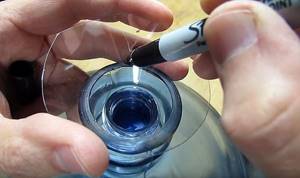
Advantages
A plastic bottle was often used on the farm as a water trough. But you can make a high-quality drinking bowl out of it. Which will be able to provide water to the entire population of chickens.
For example, design a vacuum or nipple version. Such products ensure clean water. Safe to use.
A plastic bottle cannot be broken. And if all the edges and cuts are processed correctly, you cannot get hurt on it.
Such drinkers are easy to use. You can change the water or clean it from dirt at any time.
If any part bends or breaks, you won’t have to spend money on repairs. It's easier and faster to throw it away and make a new one.
The plastic bottle is highly translucent. Any water contamination becomes immediately noticeable.
Other benefits
Bottle drinkers are used when keeping chickens on litter and in battery cages. Placed indoors or in a cage. They can be installed in a walking enclosure. Or hang it outside the cage.
The advantage of a design made from plastic bottles is that it connects directly to the water supply. This feature saves time when keeping a large number of chickens.
If it is impossible to connect the drinker to an uninterrupted water supply, it is recommended to regularly monitor the water level.
Interesting option
This container can also be adapted for feeding chickens. In principle, all feed and drinking equipment in the poultry house can be made from plastic bottles.
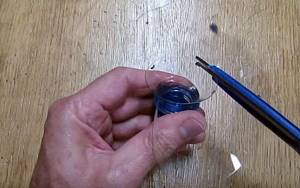
In order for the bird to eat well without scattering or contaminating the food, it is preferable to make feeders, like drinking bowls, of a closed type.
It is recommended to use food and water containers. You should not design products from bottles that contained chemicals.
A drinking bowl or feeder for chickens must be safe for health. Non-toxic, without chemical compounds.
Minus
The disadvantage of equipment made of thin plastic is the freezing of water in the cold season.
But this problem can be solved by heating the entire territory of the poultry house. There are other options described in the article “Do-it-yourself winter waterers for chickens.”
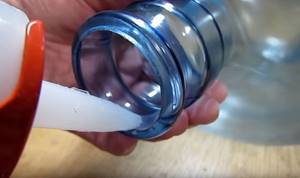
Types of structures
They are classified according to various parameters, each of which will be considered separately.
By material
Properly selected material for the feeder is the key to preserving the feed, and therefore saving it. It could be:
Tree. Wooden feeders are one of the most common options, as they are perfect for pouring dry food - grain, animal feed, and various mineral supplements. In addition, wood is a natural material that provides the product with durability. Plastic. Chickens must be given mash in their diet. It is best to pour wet food into plastic feeders, since food debris can be easily removed from their surface.
However, in this case, special attention will need to be paid to the choice of high-strength plastic. Metal
Like the previous material, it is suitable for making containers into which wet mixed food can be poured. It can also be used to make green grass bins. However, it is worth considering that black material tends to rust when exposed to moisture, and stainless steel is quite expensive.
Feeders for chickens are mainly made of wood and plastic, the choice among which depends on what kind of food you plan to use the tray for in the future.
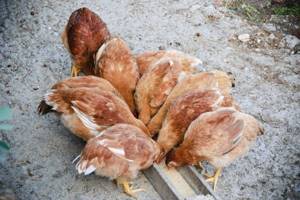
According to the method of feeding
Depending on the type of food supplied to the feeder, the convenience of feeding the bird will depend, because it is much more convenient to pour feed once a day, rather than several times at short intervals. Here are the optimal feeders for the type of food served:
- Tray. The simplest designs that are suitable for feeding young animals. The tray model is a simple container with sides that prevent food from spilling out. As a rule, such a feeder has an elongated shape.
- Grooved. Such designs are complemented by a turntable or a removable demarcation grid (mesh). Inside they are divided by partitions into several compartments (compartments) intended for different types of food. Trough feeders can be placed outside the cage so that hens can reach the feed with their heads only. This will greatly simplify not only the feeding process, but also cleaning the container.
- Bunker (automatic). Used to supply dry food. Their main advantage is that the breeder only needs to pour feed or grain into the feeder in the morning. This volume will be enough for the birds to feed all day long. The design of such devices is made in such a way that the feed comes from a closed hopper into the trays as needed, so it does not become dirty throughout the day and remains dry.
By location
Depending on the location in the chicken coop, there are two types of feeders:
- floor-mounted – mobile structures that can be installed in any part of the cage or poultry house;
- hinged - structures that, using special brackets or holding devices, are fixed to the wall of the poultry house, therefore they are stable, which compares favorably with mobile feeders that can be overturned by chickens.
Some poultry keepers use both types of feeders at the same time, as each has its own advantages.
How to place it correctly?
It is not enough to make a drinking bowl for a chicken coop or cage of high quality; it also needs to be placed in the most suitable place for this purpose. Birds must always have access to clean water. This applies to both the chicken coop itself and the bird walking area.
If we are talking about a nipple drinker, it must be installed at a certain angle.
It is most convenient to place drinking bowls near the walls. It is also recommended to place bird feeders there. This arrangement of containers is due to the fact that chickens are not the neatest birds and can scatter food and splash water. It is also permissible to install drinking bowls between perches or nests. The main thing is that they are clearly visible to all chickens.
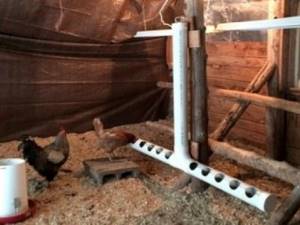
Nipple drinker for chickens: device, principle, how to assemble it yourself
How nice it is to eat eggs and chicken meat obtained from your own backyard. Of course, you still need to try for this, because it will not be possible to achieve high egg production and weight gain in meat breed chickens without proper provision of feed and water.
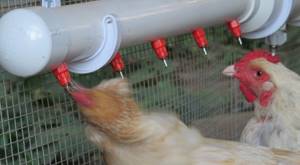
In fact, caring for chickens on a private backyard does not require any extra costs or special knowledge. It is enough to create a diet, know when and in what quantities to feed and water, depending on what you are raising the bird for.
In this material we will talk about nipple drinkers for chickens - drinking systems that facilitate and automate the process. Let's consider the advantages and disadvantages of such drinkers, as well as several options for assembling and installing them yourself.
How to make?
It is not without reason that we suggest you make a trough feeder for broilers with your own hands, since this is practically the simplest design. You don’t even need to have any drawings to make it yourself. However, note that there are several options for trough feeders. You can choose the most suitable one for your farm. You can also choose any material: sheet metal, plywood, plastic.
Grooved option
The basis of such a product is a gutter, that is, a recess into which food is poured.
- galvanized sheet;
- knife;
- plywood;
- nails, hammer;
- wooden plank.
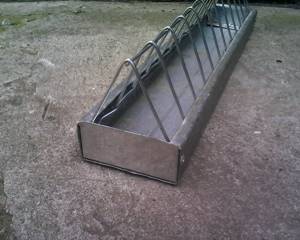
Ready-made container with gutter
Step-by-step instruction
- Let's get started by making the base of the future feeder. To do this, take a galvanized sheet and mark its dimensions based on the drawing.
- We bend the galvanized sheet along the marked lines, forming a convenient horizontal gutter.
- Now you need to make the plywood side walls. Let's cut them out.
- We attach the plywood sides to the galvanized sheet using nails.
- We attach two more side planks to the finished structure with nails and attach a round wooden plank on top. It is better to make it spinning so that the chickens cannot sit on it and dirty the food.
- To protect food from being scattered, you can make an additional grid out of wire.
Tray version made of plastic pipe
A piece of pipe can be found at any owner, so making this version of the feeder will not lead to financial costs.
- plastic pipe;
- two plugs;
- wooden slats and legs or wire for hanging;
- knife.
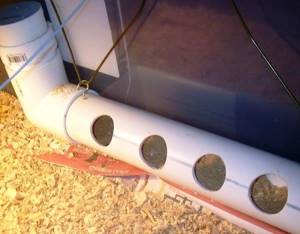
Finished plastic product
Manufacturing
- To make a do-it-yourself tray feeder for broilers, take a plastic pipe and cut round holes in it in a checkerboard pattern, as in the photo.
- We close the two edges with caps. We attach wooden strips to both sides with self-tapping screws to attach the legs.
- We attach legs or wire for hanging.
- Everything is ready, you can pour in the food.
How to wash a drinking bowl
Vacuum, nipple drinkers and other varieties must be regularly washed to remove biofilm, sediment and mucous deposits. A wide range of special sanitizing preparations are available on the market. Among the available means, a concentrated solution of hydrogen peroxide has proven to work well in cleaning.
To wash a 10 m structure made of 2 cm thick pipes, you will need 10-12 liters of hydrogen peroxide, diluted to 3%. The cleaning process itself begins with draining the drinking water. Next, the empty drinking bowl is filled with a sanitizing solution.
To completely clean its interior, it is recommended to leave the disinfectant for a day or more, and then thoroughly rinse the entire structure. This procedure is carried out as the structure becomes dirty. In summer, cleaning is required every 1-1.5 weeks.
A poultry drinking bowl made from a plastic pipe is one of the simple and affordable options.
Having the necessary materials, available tools and step-by-step instructions on hand, anyone can create a design suitable for a specific number of chickens.
Feeder for chickens made of PVC pipes
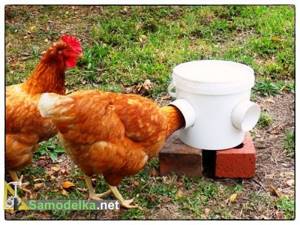
Dear visitors to the site “Visiting Samodelkin”, from the material presented by the author you will learn how to independently make economical and very easy-to-use chicken feeders from an ordinary plastic bucket and polypropylene pipes (corners).
People who raise chickens in rural areas know very well how carelessly they treat the feed poured into open feeders; a quarter can simply be scattered around the yard and trampled into the dirt with their paws. Also, if the feeder is in the open air (on the street in the courtyard of the house), then migratory birds often fly up to eat)) Rodents do not disdain chicken feed, they mostly feed on the feeder in the quiet night time, while the chickens are sleeping on the roost) In general, food loss They are quite large, sometimes even half of them will go to nowhere. For this reason, the author decided to create an economical and very easy-to-make feeder from a plastic bucket and PVC pipes (corners).
The principle is as follows: we take a plastic bucket and drill holes in the side of it, where polypropylene corners are then inserted; they should be located at a distance of 2-3 cm from the bottom. That is, when the bucket is completely filled with food, it will slowly settle as it is consumed by his chickens, “Everything is as simple as daylight.” You can also optionally make a viewing window, so you can see the level of filling of the bucket with food when the lid is closed.
So, let's look at what exactly the author will need to create a chicken feeder from PVC pipes?
1. plastic bucket 10-15 l2. polypropylene corners 70 mm3. sealant4. hot glue5. transparent plastic6. rivets
1. drill with a 70 mm2 core drill. hot glue gun3. riveter4. sealant gun5. stationery knife6. ruler7. marker
Step-by-step instructions for making a chicken feeder from PVC pipes and a plastic bucket with your own hands.
As already mentioned above, the loading hopper is a regular plastic bucket, in this case 10 liters and three corners on the sides to get the chicken head inside the feeder) You can also use a larger container, for example a 20 liter bucket or a barrel. If you need a long-lasting feeder, so that you fill it with food once and forget it for a week, then it is rational to use a plastic barrel of 40-50 liters. In general, the idea can be developed further and improvements made. And so, first of all, the author prepared the following components: a plastic bucket 10 l, 70 mm polypropylene corners and sealant with a gun.
As you can see, the feeder made from a plastic bucket and polypropylene corners turned out to be as closed as possible and the chickens will no longer scatter their food, grain losses will be sharply reduced. The birds will also stop feeding and feeding. The materials for production are inexpensive and publicly available, step-by-step instructions are provided to you, so let’s take it and do it. Be brave, friends!
Advantages: minimal feed loss, lightness and mobility, large bunker volume.
Disadvantages: when the feed is used up, the weight of the feeder will decrease and the chicken may turn it over; it is necessary to modify it and make a stable stand.
This is where I end the article.
Thank you all very much for your attention! Come visit often and don’t miss out on new items in the world of homemade products!
DIY chicken drinkers photo original ideas
What do you need to remember before making?
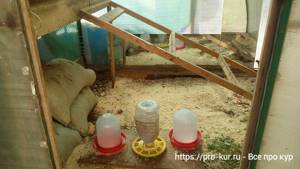
Novice poultry keepers, without thinking about the consequences, sometimes place an open plate of water for the chicks. This leads to the following incidents:
- frisky chicks may accidentally knock over the container and be left without water for a while;
- In such drinking bowls a lot of dust settles, midges fly in, and pieces of food remain. Thus, the disease begins to develop, and drinking chicks can become infected;
- birds may accidentally fall into the water and get wet, and some may drown;
The big advantage of a high-quality drinking bowl is that you don’t need to wash it so often and sometimes add water.
Before making, calculate how much water the chickens drink per day. It depends on the livestock. The more heads, the more water will be required. In order not to add water to the drinker so often, you need to choose the appropriate size. Or you can do several at once! This way the chickens will not choke and will be more comfortable.
Hens and chicks drink twice as much water per day as they consume feed. For example, for 0.5 liters of food there is 1 liter of clean water.
Also, we must not forget about safety. Do-it-yourself drinking bowls for chickens should not be made from metal materials or sharp objects.
In winter, hens and chicks definitely need warm water, otherwise they will get sick. Many experts recommend wrapping the drinker with a cable and connecting it to the network. This is much more convenient than boiling water in a kettle every time.
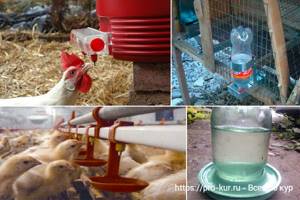
Making a nipple drinker
Operating principle
Nipple (drip) drinker saves water by 50% compared to other designs designed for drinking chickens.
The water is stored in a reservoir from which nipples emerge. When the chickens touch them with their beaks, liquid begins to drip. The bird will not be able to choke or get the bedding, feathers, or paws too wet.
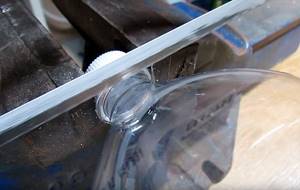
Tools and assembly process
To construct a sippy cup with nipples from a plastic container you will need:
- 5 liter bottle;
- 1 nipple;
- sealant or similar material;
- electric drill;
- fasteners.
A hole is drilled in the bottle cap to match the diameter of the nipple. A nipple is inserted into the resulting hole and secured with sealant.
Water is filled into the bottle. The structure is turned over and in this position is attached, for example, to the wall of a chicken coop.
This is an easy way to construct a drip drinker from a plastic bottle.
More options for making drip water containers are presented in the article: “Types of nipple drinkers for chickens.”
